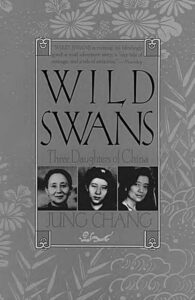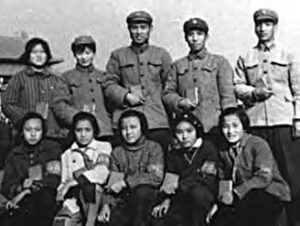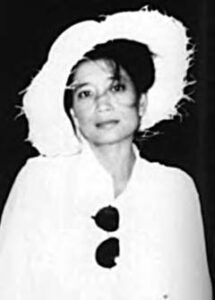by Jung Chang
NEW YORK: ANCHOR BOOKS PUBLISHED BY DOUBLEDAY, 1992
ORIGINALLY PUBLISHED BY SIMON & SCHUSTER, 1991
524 PAGES
Jung Chang’s autobiographical history, Wild Swans: Three Daughters of China, contains enough romance and adventure to interest a high school student, and enough historical and cultural detail to satisfy a history or literature teacher’s pedagogical needs. Curious yet critical, the average high school student knows little more about China than what he or she has seen in Chinese restaurants or a few square blocks of Chinatown. And, while students might be fascinated with its mystery and language, how do they approach the immense amount of history that represents China? How can the teacher, who must cover the world in nine-month semesters, make China relevant to the teenager?

Wild Swans is a book with an appealing cast of real characters who bring twentieth-century China to life with drama, romance, adventure, and historical information. They are the relatives and friends, neighbors and political figures surrounding Ms. Chang, her great-grandparents, grandparents, and parents. The book is full of personal experience and story, yet written with exceptional observation of the social and historical events of twentieth-century China. This includes the end of imperial China, the rise of the Kuomintang, the war with Japan, the civil war between the Kuomintang and the Communists, the Cultural Revolution, and the beginnings of a China opening to the West. All of this turbulence forces the family to move, and Wild Swans is set in various places, from northeastern China (Harbin), to Beijing, to the edge of the Himalayas (Xichang). Though this tremendously active and complex century would seem to be too much for a teen-age reader to grasp, Ms. Chung’s story of her life and that of her relatives, told in the first person, reads like a novel, and thus the experiences of three generations of people who move from childhood, to young adulthood, to parenthood, and to death seem real and moving.
The author’s grandmother, who was born at the end of the Manchu empire, was the daughter of a petty official who wanted his pretty daughter to help him advance in politics. Her beauty, and his lust for power, drove the father to sell her to a general in the Emperor’s army as his first concubine. Chang describes her grandmother’s life with detail and drama, elucidating the themes of military power brokering, family and village relationships, and the helpless position of women in society, both as wives and concubines. The birth of Chang’s mother, the death of her grandfather, and subsequent remarriage of her grandmother, give us a study into the foreign, yet at the same time familiar, stresses and struggles of a single mother. These themes are covered in high school classrooms again and again; the perspective given here is fascinating in its unique character, yet valuable in its universality.
Jung Chang’s own mother was born just as the Kuomintang was being confronted in Manchuria by an invasion of the Japanese army; mother and child became refugees fleeing from Japanese forces. The later rise of the Communist Party is seen as almost a logical development for these people who had been exploited first by the warlords, then the Kuomintang, and finally by the Japanese. The reader sees clearly how these common people react to changes in power, and the teacher can discuss these traumas as shapers of China’s present political course. The pain of war with the Japanese, the Kuomintang-Communist Civil War, and the formation of the People’s Republic are the backdrop for the coming of age of Chang’s parents. The communist idealism of her mother and father are appealing and understandable, as well as representative of the generation which engendered and stabilized the Communist Party in China.

During the course of Chang’s childhood and youth, we see her own and her parents’ idealism change to a struggle to believe in the Communist Party, and we wonder at their hard work and loyalty to a system which seemed to cause them so much pain. The teen-aged Chang and her friends were fervent in their devotion to Mao Zedong, and eventually joined the Red Guard during the Cultural Revolution to “suppress counterrevolutionaries,” even though this eventually included her parents. Though her desire to live out the glorious goals of Chairman Mao comes into stark conflict with the Party’s (and especially the evil Ting family’s) persecution of her parents, through her eyes we understand the person who was and is Chinese: the young girl caught by the fervor of the times; the girl who is also loyal to the traditions of Confucianist China, especially filial piety.
Chang traveled around China for several reasons—at first to spread the good news about Chairman Mao’s master plan; later, to follow the orders of Chairman Mao’s Party and to be near her parents, who eventually were imprisoned by the Red Guard. She gradually becomes disillusioned with Mao, and we see her acceptance of a new era for China, as the influence of the West begins. The reader sees China geographically and socially through her eyes—the cities and the merchants, countryside and the peasants, are both well depicted by this articulate, intelligent, and objective young mind.

Wild Swans contains a family tree, a chronology, and an index of over 500 entries with references to “foot binding,” “Cultural Revolution,” “state housing,” “Nixon,” and “opium,” among other things. This vast source of information about China could be used equally well in a history, sociology, Asian studies, or world literature course. I would certainly use it to supplement the reading of other novels by Asian American writers in my high school literature class. It provides description and commentary on many themes used by Amy Tan and Maxine Hong Kingston in their novels, as well as by Ruthanne Lum McCunn in her fictionalized biography, A Thousand Pieces of Gold. I would use it as a main text in an Advanced Placement Literature course, as its quality of writing provides a fine example of autobiographical narrative style.
Because it is rather long, it could be studied using a jig-saw method, as the chapters break themselves into sections well, and each section is descriptive and complete in itself. I could well imagine a history teacher using Wild Swans to introduce his students to China, helping them understand the historical fear Americans have had toward China, and the importance of Nixon’s visit to the country. A sense of the population, geography, and economic market can be grasped as Chang travels around observing and experiencing economic hardship. Wild Swans: Three Daughters of China is a vivid and entertaining glimpse into a foreign power during a turbulent era. It is told in the voice of a young girl living the times, yet with the hindsight of an intelligent, perceptive woman looking back at her life and that of her ancestors. It is an accessible and personal way for high school students to approach an understanding of the vast Chinese nation.

